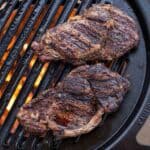How to Grill Steaks Over Live Fire
Grilled steaks over open fire has been a tradition for tens of thousands of years. Learn how easy it is to grill steaks over open fire or in a fire pit using a grill accessory. From camping to the beach, you can get amazing flavor and perfectly grilled steaks over open fire every time.
Yield: 2 steaks
Cost: $44
Equipment
- 1 Open Fire Pit (We cooking on the Solo Stove Bonfire with Hub and Grill Grate)
- 1 Pair Long Tongs
- 1 Heat Resistant Gloves
Materials
- 8 pieces cooking wood
- 1 piece tumbleweed fire starter
- ¼ cup beef seasoning
- 2 tablespoons Extra virgin olive oil
- 2 Thick (1 1/2 inch) Ribeye Steaks
Instructions
- Season Steaks: Coat the steaks in olive oil and liberally apply the seasoning to all sides.
- Prepare Embers: Arrange four wood pieces in a log cabin arrangement and place the tumbleweed started underneath. Light the tumbleweed starter and ignite the wood. For longer cooks add more wood if the fire pit allows.
- After 30 minutes add two more pieces of wood and begin setting up the embers and wood in a two-zone grilling arrangement. Be sure your grill grate is added over the fire while it pre-heats. The hot embers will heat the grate. As you cook you want to keep the flames low which is why it's best to have lots of wood set the initial embers.
- Grill Over Direct Heat: Place seasoned steak on the direct side of grate over the open coals and grill for 3 to 4 minutes. The grate should be near 500 degrees Fahrenheit for a good sear. After 3 or 4 minutes you should have a nice crust formed, flip the steak and continue to grill for an additional 3 to 4 minutes over direct heat for a nice sear. Add another log to the embers to ignite. This will help set up the indirect cooking. See notes about flare ups.
- Finish Over Indirect Heat: After you have seared the two sides of the steak move to indirect side of the grill. The ambient temperature of the embers and the added log and flame will continue to cook. Grill indirect for 4 to 6 minutes and then flip again. Continue grilling 4 to 6 minutes until the steak is at your desired temperature. Unlike a traditional grill with a cover that holds heat, it's best to flip the steaks while grilling indirect half way through your cook so one side doesn't over cook. See notes about times.
- Remove and Rest: Remove the steaks when they reach your desired internal temperature as noted with a good instant read thermometer, then let rest for 10 minutes to allow carry over cooking to finish and allow the cells to start to cool and retain the moisture from the steaks. Slice and serve with your favorite sides.
Notes
Flare Ups: We grilled ribeye steaks, which have a fair amount of marbling. As the marbling renders while grilling the fat drips onto the direct embers, which will create flames. It’s unavoidable, but the best ways to minimize them is to minimize the active flame. You can use a spray bottle of water and spray when you see flames, or use long tongs to move the steak from direct to indirect to avoid it burning.
About Time: Always cook steak to internal temperature not time. This recipe has a rough estimate of how long the steaks will take to cook. Always use a high quality instant read thermometer to pull the steaks at your desired internal temperature.
Beef Internal Temperature Ranges
- Rare - 120 - 130
- Medium-Rare - 130 - 135
- Medium - 135 - 145
- Medium-Well - 145 - 155 (Consider medium)
- Well-Done - 155 + (Not recommended)
Things that impact cooking time:
- Wind and environment, light rain will cool down the flame and grate. We do not recommend grilling in heavy rain without a covered patio.
- Account for carry over cooking, the steak will increase in internal temperature 5 degrees. So if you like your steak at 135 degrees (Medium Rare) pull the steak at 130.
- Steaks vary in marbling and size, the leaner the steak the faster it will cook. The fattier the cut the more flare ups you can expect.
